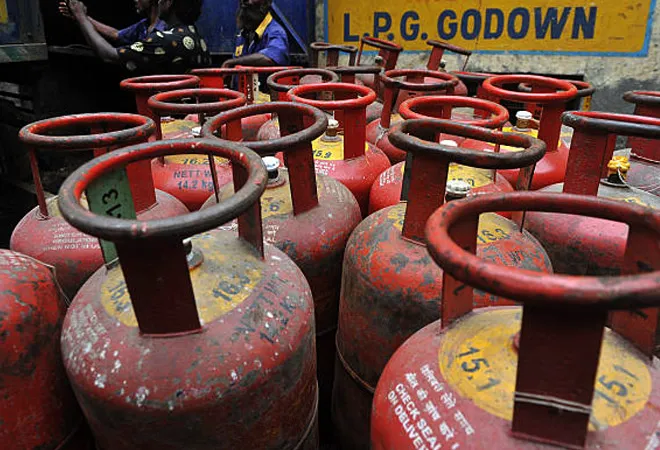
Access to clean cooking fuels and technology is an important indicator for the Sustainable Development Goal (SDG) 7, which is ensuring access to affordable, reliable, sustainable, and modern energy for all. The Ministry of Petroleum and Natural Gas (MOPNG) introduced the Pradhan Mantri Ujjwala Yojana (PMUY) in the year 2016 where deposit-free LPG connection is provided to the poor households of rural India along with the first LPG refill and stove free of cost. LPG is the most prominent among the clean fuels for cooking in India. Thus, having an LPG connection is an important indicator for SDG 7 in India.
The Government of India(GOI) announced a nationwide lockdown in March 2020 to restrict the spread of COVID-19 pandemic. The lockdown continued until the month of May followed by unlock in six phases. The Pandemic and the Lockdown influenced many aspects of the economy and overall well-being at the national as well as individual levels. This article presents the access and usage patterns of LPG among households before lockdown, during the lockdown, and post-lockdown.
The target of 8 crore LPG connections under PMUY was achieved in September 2019. All India LPG coverage was 94.3 percent in April 2019, a year before the lockdown. However, the refill rates were around 3.21 per annum for 3.18 crore PMUY beneficiaries as on 31 December 2018. Poor refill rates of LPG indicate inadequate use of this fuel. About 50 percent of rural households in the year 2018 relied on biomass (firewood, agricultural residues, and dung cakes) as their primary fuel for cooking, which is not a clean fuel for cooking as per the WHO global air quality guidelines.
As one among the relief measures during the lockdown, the GOI announced three refills of 14.2kg LPG cylinders free of cost to about 8 crore Ujjwala beneficiaries from April to June 2020. The government then extended this initiative for another three months. In 2020-21, there was an increase in refills under PMUY, with the average refills crossing four refills per annum for the first time. In the year 2020, for the first time, the sale of LPG outpaced the sale of petrol. The consumption of LPG was 27.41 million tons, i.e., 4.3 percent more than the previous year.
The World Bank conducted three rounds of household-level survey in rural India during the pandemic to assess the evolving impact. The survey gathered data for the dominant cooking fuel used in the households for three states—Bihar, Uttar Pradesh, and Madhya Pradesh. Figure 1 presents the dependence of sample rural households on LPG as the main cooking fuel in these states during the year 2020. The figure clearly indicates an increase in the dependence on LPG by the sample rural households in Bihar and Uttar Pradesh during the period from July to September 2020. A recently published study mentions that during the COVID-19 lockdown, many rural households have shifted from clean fuel to firewood and dung cakes for cooking across Bihar, Madhya Pradesh, and Uttar Pradesh due to disruption in supply on one hand, and loss of income and livelihood on the other. This published study, however, used two different data sources for pre- and post-lockdown scenario.
Figure 1 Percentage of Sample Rural Households using LPG as their Primary Cooking Fuel during Free LPG Refill Phase
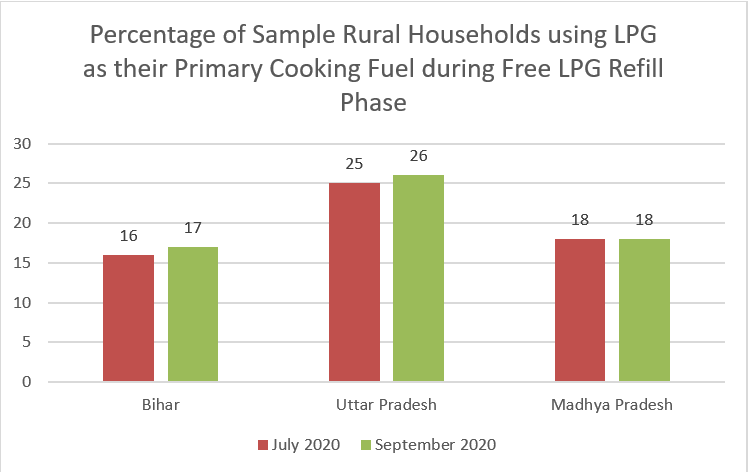
Source 1 Author's Own based on the data from The World Bank
A majority of the free refills were in five states which included Uttar Pradesh (2.7 Crores), Bihar (1.5 Crores), and Madhya Pradesh (more than 1 crore). Figure 2 presents the per annum LPG refill rates for three financial years, 2019-20 to 2021-22 in the above mentioned states. The LPG refill rates increased in the year 2020-21 and then decreased in the year 2021-22. However, the refill rates for the year 2021-22 are higher than that in the year 2019-20. At pan-India level, the average refill rates increased from 3.01 per annum (2019-20) to 4.30 per annum (2020-21). The refill rates again dropped to 3.66 per annum in the following year. i.e. 2021-22).
Figure 2 LPG Refill Rates (Per Annum)
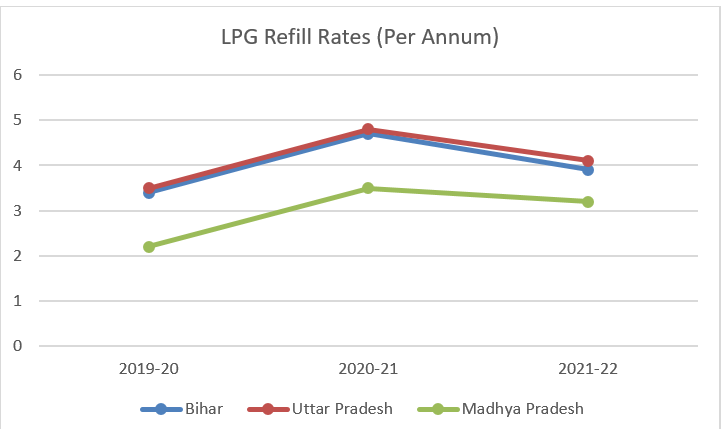
Source 2 Author’s Own based on the Information collated from Factly
The LPG coverage was announced to be 99.98 percent as on April 2021, an increase of about 5.6 percent from the year 2019. In July 2022, about 30 percent of the LPG connections in India were through PMUY. Figure 3 presents LPG access figures for the rural and urban population from a single data source. The figure clearly indicates an increase in percentage of population in rural as well as urban India in the years from 2018 to 2020. This increase is by 11 percent in rural areas and by 3 percent in urban locations. The access figures for LPG is corroborated with the LPG consumption figures at Figure 4. The overall LPG consumption in India increased by 3,423 thousand metric tonnes from the year 2018-19 to 2021-22. A comparison of National Sample Survey Figures and Indian Residential Energy Survey indicates that the percentage of rural households using LPG as primary cooking fuel increased from 48 percent to 61 percent from the year 2018 to 2020. The corresponding figures for urban India is 85 percent to 95 percent. An informal interaction with LPG users under PMUY indicated that the users availed the free refill benefits. But now they refill their LPG cylinders as per their affordability level and LPG requirement.
Figure 3 Access to Clean Cooking Fuels and Technologies in India (% of Population)
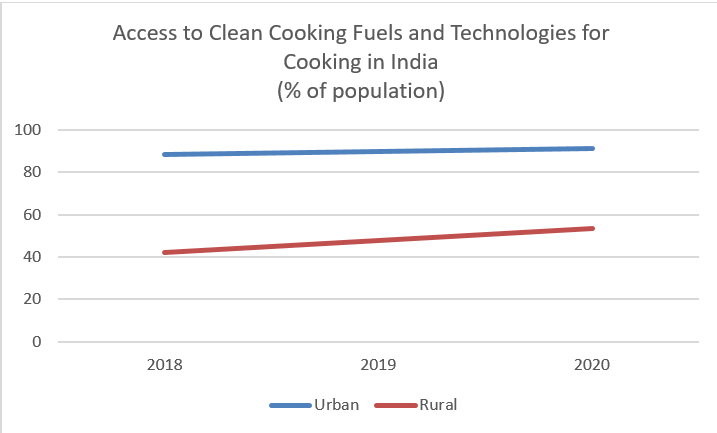
Source 3 Author's Own Based on the Data from The World Bank
Figure 4 LPG Consumption in India (000' metric Tonnes)
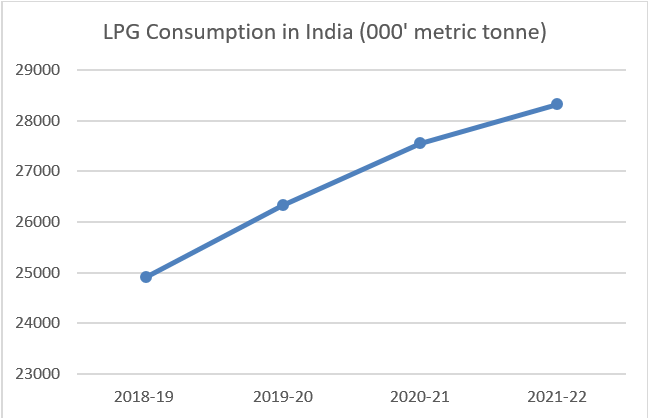
Source 4 Author's Own Based on the Data from Petroleum Planning and Analysis Cell
PMUY achieved success in terms of access. Affordability has been always one among the reasons for poor LPG refills. In rural locations, the availability of wood, agricultural residues and dung cakes, that too free cost (although it incurs investment in terms of time and labour) makes LPG the secondary cooking fuel among many households in spite of having the LPG connection. The announcement of free refills of LPG cylinders and other factors (such as staying more of indoors in urban locations) increased the overall refill rates in India during lockdown. The refill rates dropped in the following year. However, the percentage of households and population relying on LPG for cooking and consumption of LPG continued to increase from the year 2018 to 2020, especially in rural areas. PMUY played a considerable role in increasing access to LPG. Increase in access to LPG in turn increased the overall usage of LPG for cooking purpose at Country level. The short-term relief measure of free LPG refills was one among the reasons for increased refill rates for the period in spite of the various economic factors associated with lockdown and post lockdown phases. The latest available data from large surveys is for the year 2020. Availability of such data for the later years is expected to provide a much clearer scenario of overall influence of lockdown on LPG access and usage in India.
The first round of the survey was conducted in May 2020 (Lockdown) while the second round was conducted immediately after the lockdown in July 2020 (Post Lockdown). The latest and third round was conducted in September 2020. About 99% of the data (which is 5200 households in Round 3 and 5005 households in Round 2) are collated from six states. However, the data on clean cooking fuels is available for only three states (Bihar, Uttar Pradesh and Madhya Pradesh) and only for the Rounds 2 & 3. The sample size for the three states in Round 2 and 3 are 2697 and 2674, respectively.
The indicator, ‘cooking fuel used by the household at the time of survey’, is one among the list of indicators and is not an indication about complete shift of the respective households to LPG.
The views expressed above belong to the author(s). ORF research and analyses now available on Telegram! Click here to access our curated content — blogs, longforms and interviews.








 PREV
PREV


